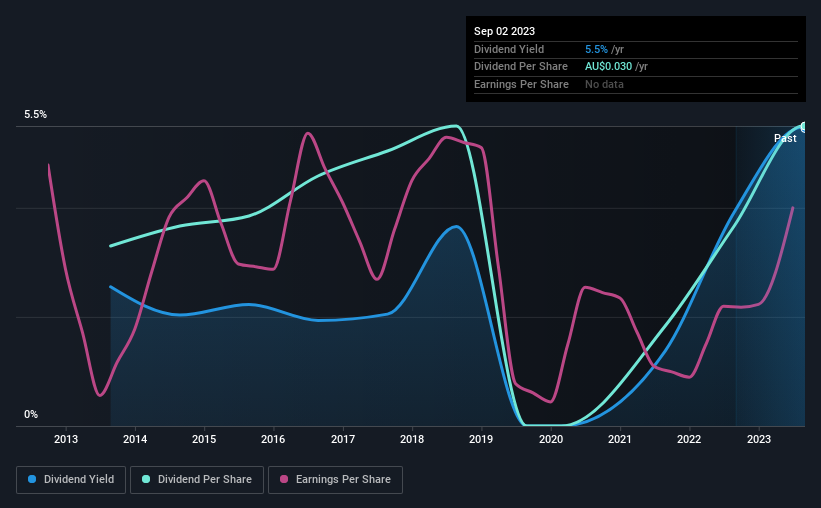We Wouldn't Be Too Quick To Buy ClearView Wealth Limited (ASX:CVW) Before It Goes Ex-Dividend
ClearView Wealth Limited (ASX:CVW) is about to trade ex-dividend in the next three days. Typically, the ex-dividend date is one business day before the record date which is the date on which a company determines the shareholders eligible to receive a dividend. It is important to be aware of the ex-dividend date because any trade on the stock needs to have been settled on or before the record date. In other words, investors can purchase ClearView Wealth's shares before the 6th of September in order to be eligible for the dividend, which will be paid on the 22nd of September.
The company's next dividend payment will be AU$0.03 per share, on the back of last year when the company paid a total of AU$0.03 to shareholders. Based on the last year's worth of payments, ClearView Wealth stock has a trailing yield of around 5.5% on the current share price of A$0.55. Dividends are an important source of income to many shareholders, but the health of the business is crucial to maintaining those dividends. As a result, readers should always check whether ClearView Wealth has been able to grow its dividends, or if the dividend might be cut.
See our latest analysis for ClearView Wealth
Dividends are typically paid out of company income, so if a company pays out more than it earned, its dividend is usually at a higher risk of being cut. ClearView Wealth paid out 92% of its earnings, which is more than we're comfortable with, unless there are mitigating circumstances.
Generally, the higher a company's payout ratio, the more the dividend is at risk of being reduced.
Click here to see how much of its profit ClearView Wealth paid out over the last 12 months.
Have Earnings And Dividends Been Growing?
Businesses with shrinking earnings are tricky from a dividend perspective. If earnings decline and the company is forced to cut its dividend, investors could watch the value of their investment go up in smoke. ClearView Wealth's earnings per share have fallen at approximately 6.1% a year over the previous five years. When earnings per share fall, the maximum amount of dividends that can be paid also falls.
Many investors will assess a company's dividend performance by evaluating how much the dividend payments have changed over time. In the past 10 years, ClearView Wealth has increased its dividend at approximately 5.2% a year on average. The only way to pay higher dividends when earnings are shrinking is either to pay out a larger percentage of profits, spend cash from the balance sheet, or borrow the money. ClearView Wealth is already paying out 92% of its profits, and with shrinking earnings we think it's unlikely that this dividend will grow quickly in the future.
To Sum It Up
Is ClearView Wealth an attractive dividend stock, or better left on the shelf? Earnings per share are in decline and ClearView Wealth is paying out what we feel is an uncomfortably high percentage of its profit as dividends. Generally we think dividend investors should avoid businesses in this situation, as high payout ratios and declining earnings can lead to the dividend being cut. These characteristics don't generally lead to outstanding dividend performance, and investors may not be happy with the results of owning this stock for its dividend.
So if you're still interested in ClearView Wealth despite it's poor dividend qualities, you should be well informed on some of the risks facing this stock. To that end, you should learn about the 2 warning signs we've spotted with ClearView Wealth (including 1 which is a bit unpleasant).
Generally, we wouldn't recommend just buying the first dividend stock you see. Here's a curated list of interesting stocks that are strong dividend payers.
Have feedback on this article? Concerned about the content? Get in touch with us directly. Alternatively, email editorial-team (at) simplywallst.com.
This article by Simply Wall St is general in nature. We provide commentary based on historical data and analyst forecasts only using an unbiased methodology and our articles are not intended to be financial advice. It does not constitute a recommendation to buy or sell any stock, and does not take account of your objectives, or your financial situation. We aim to bring you long-term focused analysis driven by fundamental data. Note that our analysis may not factor in the latest price-sensitive company announcements or qualitative material. Simply Wall St has no position in any stocks mentioned.

